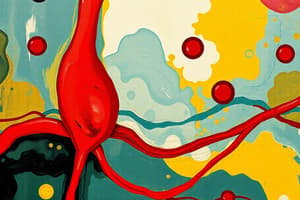Podcast
Questions and Answers
How does injury to the vascular endothelial cell layer initiate the process of coagulation?
How does injury to the vascular endothelial cell layer initiate the process of coagulation?
- By synthesizing serotonin and adenosine diphosphate (ADP) to inhibit clot formation.
- By exposing collagen and von Willebrand factors, prompting platelet adhesion and activation. (correct)
- By releasing integrin IIb/IIIa to bind with fibrinogen.
- By directly stimulating the production of thromboxane A2.
What is the primary mechanism by which activated platelets contribute to vasoconstriction during the coagulation process?
What is the primary mechanism by which activated platelets contribute to vasoconstriction during the coagulation process?
- By releasing collagen to activate von Willebrand factors.
- By synthesizing thromboxane A2 from arachidonic acid. (correct)
- By inhibiting the conformational changes in the platelet receptor integrin IIb/IIIa.
- Activating prothrombin
Which of the following is the direct result of conformational changes in the platelet receptor integrin IIb/IIIa?
Which of the following is the direct result of conformational changes in the platelet receptor integrin IIb/IIIa?
- Synthesis of thromboxane A2 from arachidonic acid.
- Release of serotonin and adenosine diphosphate (ADP).
- Binding of fibrinogen and subsequent platelet plug formation. (correct)
- Exposure of collagen and von Willebrand factors.
How does Antithrombin III (ATIII) impede the clotting cascade?
How does Antithrombin III (ATIII) impede the clotting cascade?
If a drug is designed to mimic the action of Antithrombin III, what primary effect would it have on the coagulation process?
If a drug is designed to mimic the action of Antithrombin III, what primary effect would it have on the coagulation process?
How does heparin accelerate the action of antithrombin?
How does heparin accelerate the action of antithrombin?
Why is fondaparinux considered to have a lower risk of heparin-induced thrombocytopenia (HIT)?
Why is fondaparinux considered to have a lower risk of heparin-induced thrombocytopenia (HIT)?
What is the primary rationale behind using argatroban to treat heparin-induced thrombocytopenia (HIT)?
What is the primary rationale behind using argatroban to treat heparin-induced thrombocytopenia (HIT)?
Which of the following best explains why protamine sulfate is administered in cases of heparin overdose?
Which of the following best explains why protamine sulfate is administered in cases of heparin overdose?
How do direct thrombin inhibitors like hirudin and bivalirudin differ from heparin and LMWH in their mechanism of action?
How do direct thrombin inhibitors like hirudin and bivalirudin differ from heparin and LMWH in their mechanism of action?
What is a key distinction between the actions of hirudin and argatroban as parenteral direct thrombin inhibitors?
What is a key distinction between the actions of hirudin and argatroban as parenteral direct thrombin inhibitors?
How does warfarin inhibit the coagulation cascade?
How does warfarin inhibit the coagulation cascade?
Why is the International Normalized Ratio (INR) used when monitoring patients on warfarin?
Why is the International Normalized Ratio (INR) used when monitoring patients on warfarin?
What distinguishes tissue plasminogen activators (t-PAs) from streptokinase in their mechanism of action?
What distinguishes tissue plasminogen activators (t-PAs) from streptokinase in their mechanism of action?
How does aspirin inhibit platelet aggregation?
How does aspirin inhibit platelet aggregation?
Why is aspirin considered an irreversible inhibitor in the context of platelet function?
Why is aspirin considered an irreversible inhibitor in the context of platelet function?
What is the mechanism of action of clopidogrel and ticlopidine in preventing platelet aggregation?
What is the mechanism of action of clopidogrel and ticlopidine in preventing platelet aggregation?
How do drugs like abciximab, eptifibatide, and tirofiban prevent platelet aggregation?
How do drugs like abciximab, eptifibatide, and tirofiban prevent platelet aggregation?
Which of the following correctly pairs a drug with its primary target in the coagulation pathway?
Which of the following correctly pairs a drug with its primary target in the coagulation pathway?
How does Desmopressin acetate assist in treating bleeding disorders?
How does Desmopressin acetate assist in treating bleeding disorders?
How does antithrombin inhibit the coagulation cascade?
How does antithrombin inhibit the coagulation cascade?
What is the most significant difference between unfractionated heparin (UFH) and low molecular weight heparin (LMWH) concerning their administration?
What is the most significant difference between unfractionated heparin (UFH) and low molecular weight heparin (LMWH) concerning their administration?
What is a critical consideration when switching a patient from UFH to LMWH?
What is a critical consideration when switching a patient from UFH to LMWH?
Why is fondaparinux administered subcutaneously despite not being a heparin?
Why is fondaparinux administered subcutaneously despite not being a heparin?
How do the mechanisms of action of unfractionated heparin, low molecular weight heparin and fondaparinux differ?
How do the mechanisms of action of unfractionated heparin, low molecular weight heparin and fondaparinux differ?
Why is argatroban used in the treatment of heparin-induced thrombocytopenia (HIT)?
Why is argatroban used in the treatment of heparin-induced thrombocytopenia (HIT)?
In a patient receiving unfractionated heparin (UFH) who requires urgent surgery, why is protamine sulfate the preferred reversal agent?
In a patient receiving unfractionated heparin (UFH) who requires urgent surgery, why is protamine sulfate the preferred reversal agent?
Why is plasmapheresis required to reverse the effects of some low molecular weight heparins?
Why is plasmapheresis required to reverse the effects of some low molecular weight heparins?
Unfractionated Heparin (UFH) is the drug of choice in pregnancy. Why?
Unfractionated Heparin (UFH) is the drug of choice in pregnancy. Why?
Why is the effectiveness of coumadin (warfarin) monitored by the blood test Prothrombin Time (PT)?
Why is the effectiveness of coumadin (warfarin) monitored by the blood test Prothrombin Time (PT)?
Why do the clinical effects of coumadin (warfarin) take a week or more to kick in?
Why do the clinical effects of coumadin (warfarin) take a week or more to kick in?
What is the primary advantage of using oral direct Factor Xa inhibitors like rivaroxaban and apixaban over warfarin?
What is the primary advantage of using oral direct Factor Xa inhibitors like rivaroxaban and apixaban over warfarin?
What is the significance of 'andexanet alpha' in the context of oral direct Factor Xa inhibitors?
What is the significance of 'andexanet alpha' in the context of oral direct Factor Xa inhibitors?
How do direct thrombin inhibitors differ mechanistically from heparin?
How do direct thrombin inhibitors differ mechanistically from heparin?
While argatroban requires monitoring with aPTT, dabigatran, another Direct Thrombin Inhibitor, does not. Why?
While argatroban requires monitoring with aPTT, dabigatran, another Direct Thrombin Inhibitor, does not. Why?
Why is plasmin crucial for the action of fibrinolytic drugs?
Why is plasmin crucial for the action of fibrinolytic drugs?
How do tissue plasminogen activators (t-PAs) like alteplase differ from streptokinase in their mechanism of action?
How do tissue plasminogen activators (t-PAs) like alteplase differ from streptokinase in their mechanism of action?
Which of the following accurately describes how ticlopidine, clopidogrel, and prasugrel inhibit platelet aggregation?
Which of the following accurately describes how ticlopidine, clopidogrel, and prasugrel inhibit platelet aggregation?
How do abciximab, eptifibatide, and tirofiban prevent platelet aggregation?
How do abciximab, eptifibatide, and tirofiban prevent platelet aggregation?
Which of the following are direct thrombin inhibitors that bind to two different sites on thrombin? (Select all that apply)
Which of the following are direct thrombin inhibitors that bind to two different sites on thrombin? (Select all that apply)
Which of the following are direct thrombin inhibitors that bind only to the thrombin active site?
Which of the following are direct thrombin inhibitors that bind only to the thrombin active site?
Which of the following is the recombinant form of hirudin?
Which of the following is the recombinant form of hirudin?
Warfarin can be used in pregnancy as it does not cross the placenta?
Warfarin can be used in pregnancy as it does not cross the placenta?
How do you reverse warfarin?
How do you reverse warfarin?
What is the mechanism of action (MOA) of Streptokinase?
What is the mechanism of action (MOA) of Streptokinase?
Which of the following is the human enzyme synthesized by the kidney that converts plasminogen to plasmin?
Which of the following is the human enzyme synthesized by the kidney that converts plasminogen to plasmin?
Which of the following are recombinant Tissue Plasminogen Activators (t-PAs)?
Which of the following are recombinant Tissue Plasminogen Activators (t-PAs)?
Which of the following inhibits prostaglandin synthesis?
Which of the following inhibits prostaglandin synthesis?
Which of the following drugs' mechanism of action is to inhibit ADP-induced platelet aggregation?
Which of the following drugs' mechanism of action is to inhibit ADP-induced platelet aggregation?
Which of the following drugs block IIb/IIIa receptors on platelets?
Which of the following drugs block IIb/IIIa receptors on platelets?
Aspirin is an irreversible inhibitor of thromboxane A2
Aspirin is an irreversible inhibitor of thromboxane A2
Which of the following would be used in a patient with an aspirin allergy? (Select all that apply)
Which of the following would be used in a patient with an aspirin allergy? (Select all that apply)
Which of the following are low molecular weight heparins?
Which of the following are low molecular weight heparins?
What is the antidote for excess dabigatran?
What is the antidote for excess dabigatran?
Flashcards
Thrombosis
Thrombosis
Vessel occlusion due to a blood clot.
Hemostasis
Hemostasis
Regulation of the blood clotting system to prevent excessive bleeding or clotting.
Thromboxane A2
Thromboxane A2
Platelets synthesize this from arachidonic acid, leading to platelet activation and vasoconstriction.
Serotonin and ADP
Serotonin and ADP
Signup and view all the flashcards
Integrin IIb/IIIa
Integrin IIb/IIIa
Signup and view all the flashcards
Prothrombin
Prothrombin
Signup and view all the flashcards
Thrombin
Thrombin
Signup and view all the flashcards
Fibrinogen
Fibrinogen
Signup and view all the flashcards
Antithrombin III (ATIII)
Antithrombin III (ATIII)
Signup and view all the flashcards
Indirect Thrombin Inhibitors
Indirect Thrombin Inhibitors
Signup and view all the flashcards
Heparin
Heparin
Signup and view all the flashcards
Protamine Sulfate
Protamine Sulfate
Signup and view all the flashcards
Fondaparinux
Fondaparinux
Signup and view all the flashcards
Direct Thrombin Inhibitors
Direct Thrombin Inhibitors
Signup and view all the flashcards
Hirudin
Hirudin
Signup and view all the flashcards
Warfarin
Warfarin
Signup and view all the flashcards
Fibrinolytic Drugs
Fibrinolytic Drugs
Signup and view all the flashcards
Plasmin
Plasmin
Signup and view all the flashcards
Streptokinase
Streptokinase
Signup and view all the flashcards
Aspirin
Aspirin
Signup and view all the flashcards
Blood Coagulation Enzymes
Blood Coagulation Enzymes
Signup and view all the flashcards
Antithrombin's Role in Coagulation
Antithrombin's Role in Coagulation
Signup and view all the flashcards
Unfractionated Heparin (UFH)
Unfractionated Heparin (UFH)
Signup and view all the flashcards
Low Molecular Weight Heparin (LMWH)
Low Molecular Weight Heparin (LMWH)
Signup and view all the flashcards
Heparin Induced Thrombocytopenia (HIT)
Heparin Induced Thrombocytopenia (HIT)
Signup and view all the flashcards
Treat HIT
Treat HIT
Signup and view all the flashcards
Coumadin's Action
Coumadin's Action
Signup and view all the flashcards
Reverse Coumadin
Reverse Coumadin
Signup and view all the flashcards
Oral Direct Factor Xa Inhibitors
Oral Direct Factor Xa Inhibitors
Signup and view all the flashcards
Thrombin Inhibitor Action
Thrombin Inhibitor Action
Signup and view all the flashcards
Tissue Plasminogen Activators (t-PAs)
Tissue Plasminogen Activators (t-PAs)
Signup and view all the flashcards
Antiplatelet Drugs
Antiplatelet Drugs
Signup and view all the flashcards
Study Notes
Key Terms:
- Thrombosis refers to vessel occlusion.
- Hemostasis refers to the regulation of the coagulation system.
- Injury exposes collagen and von Willebrand factors, causing platelets to adhere, activate, and form a clot.
- Platelets synthesize thromboxane A2 from arachidonic acid, leading to platelet activation and vasoconstriction.
- Activated platelets release serotonin and adenosine diphosphate (ADP), further inducing aggregation and vasoconstriction.
- Platelet activation causes conformational changes in integrin IIb/IIIa, binding fibrinogen and forming a platelet plug.
Blood Coagulation Cascade:
- Prothrombin, a protein, is converted by Factor Xa, an enzyme, into thrombin, also an enzyme.
- Thrombin, an enzyme, converts fibrinogen, a protein, into fibrin, a blood clot.
- Factor Xa is a protease enzyme targetted by antithrombin III (ATIII).
- Antithrombin III (ATIII) binds to and inactivates factors IXa. Xia, Xa, preventing the conversion of soluble fibrinogen into insoluble fibrin.
- Antithrombin III (ATIII) inhibits Factor Xa, slowing down the clotting cascade.
- Thrombin is an enzyme that converts fibrinogen into insoluble fibrin to form a blood clot.
- Many of the enzymes in the clotting cascade do not use "-ase" nomenclature and are given Roman numerals (X, XII).
Anticoagulant Drugs: Indirect Thrombin Inhibitors:
- These drugs interact with Antithrombin III, a protein in the blood.
- These drugs inactivate Factor Xa.
- Activated antithrombin blocks Factor Xa and thrombin, preventing fibrin clot formation.
- Types include unfractionated heparin (UFH), low molecular weight heparin (LMWH), and fondaparinux (a synthetic pentasaccharide).
- These drugs enhance the inactivation of factor Xa and thrombin.
Heparin:
- Heparin, a mixture of sulfated mucopolysaccharides, accelerates antithrombin action by 1000x.
- It binds to antithrombin, causing a conformational change.
- High molecular weight heparin (HMWH) has a molecular weight of 5000-30000 and is administered via injection.
- Low molecular weight heparins (LMWH) like enoxaparin, dalteparin and tinzaparin, act similarly with equal efficacy and end in "parin."
- LMWH are now preferred due to easier control of absorption, subcutaneous administration, and no need for aPTT blood test monitoring.
- Commercial heparins are sourced from bovine lung or porcine intestines.
- Unfractionated heparin (UFH) is a large molecule and can only be injected intravenously (IV) or subcutaneously (SC), not intramuscularly (IM) to avoid hematoma.
- Activated partial thromboplastin time (aPTT or PTT) is used to monitor unfractionated heparin.
- A major adverse drug reaction (ADR) of unfractionated heparin is bleeding.
- Heparin-induced thrombocytopenia (HIT), a hypercoagulable state, develops in 1-4% of patients on Unfractionated Heparin (UFH).
- HIT occurs more frequently with heparin and less with fractionated LMWH; it never occurs with fondaparinux.
- HIT is caused by an idiosyncratic immune response, where the patient develops heparin antibodies.
- HIT occurs more frequently with UFH derived from bovine sources compared to pig sources.
- Heparin is discovered in the liver.
- Heparin’s clinical uses include the prevention and treatment of venous thromboembolic disease, arterial thrombosis, and prevention of thrombosis in arterial or cardiac surgery.
- Heparin is the medication of choice during pregnancy and will not cross the placental barrier.
- Heparin antibody complexes activate platelets, leading to possible clots.
- Thrombocytopenia results from loss of platelets, as macrophages remove the heparin antibody-platelet complex which can cause platelet counts to drop from 500,000 /uL to 20,000 /uL or less.
- The remaining antibodies activate the remaining platelets leading to systemic clot formation.
- Argatroban, a direct thrombin binder, helps stop coagulation and is used as a treatment.
- Protamine sulfate neutralizes heparin and reverses excessive bleeding from overdose.
- Protamine is the drug of choice for Unfractionated Heparin (UFH).
- Protamine may partially neutralize enoxaparin.
- Protamine will not reverse fondaparinux.
- Plasmapheresis is required to reverse other low molecular weight heparins.
- Unfractionated Heparin comes from pig or cow intestines and may cause allergic reactions.
Fondaparinux:
- Fondaparinux is not a heparin, but is still too large and must be injected subcutaneously (SC).
- It is synthetically made in a lab and does not come from animal intestines unlike heparin which comes from pigs and cows.
- It binds to antithrombin which inactivates Factor Xa, similarly to heparins.
- It has a long half-life of 15 hours, allowing once-daily subcutaneous dosing.
- Protamine is ineffective with fondaparinux.
Direct Thrombin Inhibitors:
- These directly bind to thrombin and inhibit its effects.
- Heparin and LMWHs bind to antithrombin, not thrombin.
- Hirudin and bivalirudin bind to two sites on thrombin.
- Argatroban and melagatran, bind only to the thrombin active site.
Parenteral Direct Thrombin Inhibitors:
- Hirudin is derived from medical leeches (Hirudo medicinalis), specifically from the saliva of the leech.
- Lepirudin is the recombinant form of hirudin.
- Administered subcutaneously like heparin and monitored with the aPTT test.
- Bivalirudin is administered intravenously and binds to two sites on thrombin.
- Argatroban is administered intravenously monitored with aPTT.
- Argatroban is often used to treat HIT, which is a key exam question.
Oral Direct Thrombin Inhibitors:
- Warfarin and coumarin anticoagulants are a major advancement.
- Cows that ate spoiled clover feed bled to death and the spoiled feed contained bishydroxycoumarin
- Bishydroxycoumarin is found in spoiled sweet grass and is a powerful anticoagulant.
- Dicumarol and Warfarin were derived from Bishydroxycoumarin.
- Warfarin is derived from coumarin and first sold under the brand name "Coumadin".
- Warfarin and dicumarol were first sold as rat poison ("d-Con" sold and renamed "coumadin").
- Warfarin blocks prothrombin and factors VII, IX, and X, inactivating the coagulation cascade
- It blocks vitamin K epoxidase, which activates vitamin K required for clot formation.
- Coumarin anticoagulants interfere with a large number of coagulation factors all use Vitamin K for normal use.
- Warfarin is not used in pregnancy because it crosses the placental barrier (use heparins instead).
- It is dosed orally at 5-10 mg/day and monitored with prothrombin time (PT), now called International Normalized Ratio (INR).
- The target therapeutic range for INR is 2-3 and ISI is engineered to be 1
- INR is a Prothrombin Time blood test that is standardized among the world's labs.
- Clinical effects of of Warfarin may take a week or more to kick in; heparin acts immediately
- The clinical effects of Warfarin can be reversed with Vitamin K.
Fibrinolytic Drugs:
- These drugs lyse thrombi by catalyzing the formation of plasmin, a serine protease enzyme.
- Plasminogen is the inactive precursor of plasmin.
- Plasmin precursors are used instead of plasmin because it is inactivated by inhibitors in human plasma.
- Streptokinase, a protein from bacteria, binds to plasminogen and activates it to form plasmin.
- No inactivators of bacterial streptokinase exist in human plasma.
- Urokinase is a human enzyme synthesized by the kidney that converts plasminogen to plasmin and has no natural inhibitors.
- Anistreplase is a human plasminogen + bacterial streptokinase combination.
- Anistreplase is acylated and was removed from the market in the US.
- Tissue plasminogen activators (t-PAs) activate only clot-bound plasminogen.
- Alteplase, reteplase, and tenecteplase are produced by recombinant technology and are types of human t-PA.
Antiplatelet Agents:
- Agents from outside the platelet that induce platelet activation include catecholamines, collagen, thrombin, and prostacyclin.
- Agents generated inside the platelet that induce activation include ADP, prostaglandin D2, prostaglandin E2, and serotonin.
- Agents generated within the platelet that induce activation include prostaglandin endoperoxides, thromboxane A2, cAMP/cGMP, and calcium ions.
- Drugs to stop platelet activation block these factors. Drug targets are either within or on the platelet.
- Aspirin inhibits prostaglandin synthesis.
- Clopidogrel and ticlopidine inhibit ADP-induced platelet aggregation.
- Abciximab, tirofiban, and eptifibatide block IIb/IIIa receptors on platelets.
Aspirin:
- Thromboxane A2 produced within platelets is responsible for platelet aggregation.
- Aspirin inhibits the synthesis of thromboxane A2 in platelets.
- Aspirin inhibits the prostaglandin thromboxane A in the platelet. Aspirin inhibits COX in the platelet and is irreversible.
- Aspirin is an irreversible inhibitor, meaning the enzyme is inhibited even after the drug is cleared.
- It takes about 11 days for the platelet to be replaced with new, uninhibited platelets.
- Platelets have no nucleus and cannot synthesize new enzyme (COX).
Clopidogrel & Ticlopidine:
- Clopidogrel, prasugrel, & ticlopidine inhibit platelet aggregation by inhibiting the ADP pathway within platelets.
- They inhibit platelet aggregation by blocking ADP receptors on platelets.
- They have no effect on prostaglandin synthesis so are useful in patients allergic to aspirin.
Block Platelet Glycoprotein IIb/IIIa Receptors:
- Each platelet has approximately 50,000 of these receptors.
- Fibrinogen, vitronectin, fibronectin, and von Willebrand factor bind to the receptor and complete aggregation.
- Abciximab is a monoclonal antibody that binds to the receptor and blocks fibronectin binding etc.
- Eptifibatide is an analog of the carboxyl terminal of fibronectin that binds to the receptor and blocks fibronectin etc. binding.
- Tirofiban is similar in function and structure to eptifibatide.
- All three drugs are given parenterally.
Preventing Venous Thrombosis:
- Thrombophilia is the tendency to form thrombi.
- Causes of thrombophilia include inherited defects in the clotting cascade, prolonged bed rest, mechanical heart valves, atrial fibrillation, and cancer.
- Heparin and warfarin are used to prevent venous thrombosis.
- LMWH and fondaparinux are often used and given daily as subcutaneous injections.
Drugs Used for Bleeding Disorders:
- Vitamin K activates prothrombin and is found in leafy green vegetables.
- Vitamin K reverses excess warfarin dosing.
- K1 comes from green vegetables, while K2 is synthesized by bacteria in human GI.
- Desmopressin acetate increases factor VIII activity and can be given intranasally.
Oral Direct Factor Xa Inhibitors
- Examples include rivaroxaban, apixaban, edoxaban, and betrixaban.
- Direct Factor Xa Inhibitors all end with "xaban".
- Oral Direct Factor Xa Inhibitors are drugs used to prevent clot formation in a wide variety of conditions from hip and knee replacement to prevention of emboli in patients with atrial fibrillation.
- Blood test monitoring is not required for Direct Factor Xa Inhibitors.
- The clinical effects of the Oral Direct Factor Xa Inhibitors can be reversed with injections of andexanet alpha that binds to Factor Xa and removes all of the inhibitor drugs.
Oral Direct Thrombin Inhibitors:
- Dabigatran is administered orally, with no blood test monitoring required but aPTT will be prolonged which can be used to test for drug effect, if necessary.
- Idarucizumab is the antidote for excess dabigatran.
Required Drugs:
- Indirect Thrombin Inhibitors: heparin
- Low Molecular Weight Heparins: enoxaparin, dalteparin, tinzaparin
- Synthetic Anticoagulant: fondaparinux
- Heparin Antidote: protamine
- Coumarin Anticoagulants: warfarin
- Direct Factor Xa Inhibitors: rivaroxaban, apixaban, edoxaban
- Direct Thrombin Inhibitors: hirudin, lepirudin, bivalirudin, dabigatran (po)
Other information:
- Fibrinolytic Drugs: streptokinase, urokinase
- Antiplatelet Agents: aspirin (low dose), clopidogrel
- Block IIb/IIIa Receptors: abciximab
- Bleeding Disorder Drugs: Vitamin K
Heparin Mechanism of Action
- Heparin promotes the activity of Antithrombin, a polypeptide.
- Antithrombin, the polypeptide, inhibits many different coagulation factors (enzymes) that are all protease enzymes.
- Antithrombin inhibits factor enzymes, slowing down the coagulation cascade.
- Heparin binds to Antithrombin, conformational change in Antithrombin, makes Antithrombin a more potent inhibitor of thrombin, Factor Xa and Factor IXa.
- This happens in heparin, all the low molecular weight heparins (LMW heparins) and fondaparinux.
- Heparin is a secondary inhibitor of thrombin (an enzyme) by making the thrombin inhibitor, Antithrombin, more active.
- Unfractionated Heparin enhance antithrombin which helps inhibit many protease enzymes required to form a clot.
Warfarin Mechanism of Action
- With Warfarin the coagulation Factors II, VII, IX, X and the anticoagulant proteins C and S are "activated” by reduced (active) Vitamin K.
- If there is no “active” Vitamin K then these factors do not work and coagulation is reduced and clots will not form.
- Warfarin inhibits the enzyme that converts food ingested inactive Vitamin K into active reduced Vitamin K.
- This enzyme that it inhibits is named, gamma glutamyl carboxylase (GGC).
- Warfarin inhibits GGC, so Warfarin inhibits Vitamin K activation.
Studying That Suits You
Use AI to generate personalized quizzes and flashcards to suit your learning preferences.





